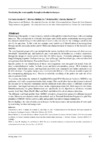Please use this identifier to cite or link to this item:
https://accedacris.ulpgc.es/jspui/handle/10553/114712
| DC Field | Value | Language |
|---|---|---|
| dc.contributor.author | Carrasco Acosta, Marina | en_US |
| dc.contributor.author | Herrera Melián, José Alberto | en_US |
| dc.contributor.author | Robaina Romero, Rafael Juan | en_US |
| dc.contributor.author | García Jiménez, M. Del Pilar | en_US |
| dc.date.accessioned | 2022-05-16T10:31:25Z | - |
| dc.date.available | 2022-05-16T10:31:25Z | - |
| dc.date.issued | 2014 | en_US |
| dc.identifier.isbn | 84-697-0471-0 | en_US |
| dc.identifier.uri | https://accedacris.ulpgc.es/handle/10553/114712 | - |
| dc.description.abstract | Monitoring of the quality of water is mainly carried out through biochemical techniques with a consuming- time cost. The development of molecular techniques and specific probes to determine microorganisms has allowed a breakthrough in the validation of water quality not only for the technique sensitivity but also for its precision. In this work two attempts were carried out i) Identification of microorganisms through specific molecular probes and ii) Molecular characterization of structure of the bacterial communities. The main bacterial groups which are included in the current legislation (Escherichia coli, Enterococcus intestinalis, Salmonella spp. and Legionella spp.) were analyzed in beaches and a wetland wastewater, through the design of specific probes from the 16S rRNA region. Potentially pathogenic filamentous fungi, belonging to genera Cladosporium spp., Aspergillus spp. and Penicillium spp., were also identified using primers from the Internal Transcribed Spacer region (ITS). Specific probes for the identification of theses microorganisms were designed and tested, from cultures in microbiological media, for both groups and their corresponding genera. DNA isolation was performed with lithium acetate, and fragments amplified were sequenced and further analyzed in the BLAST database. Phylogenic analysis was confirmed with MEGA v 5.05 software in order to generate the corresponding phylogeny trees. Results revealed the specificity of the probes for each one of the microorganisms tested. To continue, the molecular method of Amplified Ribosomal DNA Restriction Analysis (ARDRA) was performed with well–characterized molecularly strains. This would allow further the characterization of the structure of the bacterial community and the validation of the effectiveness of different wastewater treatments. This fingerprint method is based on the amplification of the 16S rRNA region for the family Enterobacteriaceae, the genus Enterococcus and specifically E.coli, digestion by restriction enzymes namely AluI, TaqI, MspI, HaeIII, HhaI and MseI, and followed by electrophoresis detection. The different sized-band profiles from ARDRA revealed a characteristic pattern for different bacterial strains. Moreover an exhaustive molecular method, such as Terminal-Restriction Fragment Length Polymorphism (T-RFLP) will be used to qualify and quantify bacterial or fungal communities. Results highlight the value of molecular techniques for the improvement and optimization of water quality monitoring for these microorganisms. | en_US |
| dc.language | eng | en_US |
| dc.source | Book of Abstracts submitted to the IV Congress of Marine Sciences. Las Palmas de Gran Canaria, June 11th to 13th 2014, p. 427 | en_US |
| dc.subject | 251001 Oceanografía biológica | en_US |
| dc.subject | 251002 Oceanografía química | en_US |
| dc.subject | 330811 Control de la contaminación del agua | en_US |
| dc.title | Monitoring the water quality through molecular techniques | en_US |
| dc.type | info:eu-repo/semantics/conferenceObject | en_US |
| dc.type | ConferenceObject | en_US |
| dc.relation.conference | IV Congress of Marine Sciences | en_US |
| dc.description.lastpage | 427 | en_US |
| dc.description.firstpage | 427 | en_US |
| dc.investigacion | Ciencias | en_US |
| dc.type2 | Póster de congresos | en_US |
| dc.description.numberofpages | 1 | en_US |
| dc.utils.revision | Sí | en_US |
| dc.identifier.ulpgc | Sí | en_US |
| dc.contributor.buulpgc | BU-BAS | en_US |
| dc.contributor.buulpgc | BU-BAS | en_US |
| dc.contributor.buulpgc | BU-BAS | en_US |
| dc.contributor.buulpgc | BU-BAS | en_US |
| item.grantfulltext | open | - |
| item.fulltext | Con texto completo | - |
| crisitem.event.eventsstartdate | 11-06-2014 | - |
| crisitem.event.eventsenddate | 13-06-2014 | - |
| crisitem.author.dept | GIR IUNAT: Biología Integrativa y Recursos Biológicos | - |
| crisitem.author.dept | IU de Estudios Ambientales y Recursos Naturales | - |
| crisitem.author.dept | GIR IUNAT: Fotocatálisis y espectroscopía para aplicaciones medioambientales. | - |
| crisitem.author.dept | IU de Estudios Ambientales y Recursos Naturales | - |
| crisitem.author.dept | Departamento de Química | - |
| crisitem.author.dept | GIR IUNAT: Biología Integrativa y Recursos Biológicos | - |
| crisitem.author.dept | IU de Estudios Ambientales y Recursos Naturales | - |
| crisitem.author.dept | Departamento de Biología | - |
| crisitem.author.dept | GIR IUNAT: Biología Integrativa y Recursos Biológicos | - |
| crisitem.author.dept | IU de Estudios Ambientales y Recursos Naturales | - |
| crisitem.author.dept | Departamento de Biología | - |
| crisitem.author.orcid | 0000-0002-7298-5457 | - |
| crisitem.author.orcid | 0000-0002-2466-6531 | - |
| crisitem.author.orcid | 0000-0003-4265-5809 | - |
| crisitem.author.orcid | 0000-0002-4732-0381 | - |
| crisitem.author.parentorg | IU de Estudios Ambientales y Recursos Naturales | - |
| crisitem.author.parentorg | IU de Estudios Ambientales y Recursos Naturales | - |
| crisitem.author.parentorg | IU de Estudios Ambientales y Recursos Naturales | - |
| crisitem.author.parentorg | IU de Estudios Ambientales y Recursos Naturales | - |
| crisitem.author.fullName | Carrasco Acosta, Marina | - |
| crisitem.author.fullName | Herrera Melián, José Alberto | - |
| crisitem.author.fullName | Robaina Romero, Rafael Juan | - |
| crisitem.author.fullName | García Jiménez, M. Del Pilar | - |
| Appears in Collections: | Póster de congreso | |
Page view(s)
39
checked on Apr 27, 2024
Download(s)
21
checked on Apr 27, 2024
Google ScholarTM
Check
Altmetric
Share
Export metadata
Items in accedaCRIS are protected by copyright, with all rights reserved, unless otherwise indicated.
